Are you overwhelmed by the hundreds of gaming monitor options and arrays of high-end features they offer?
No worries; many new users struggle to find the correct-sized gaming monitors that best fit their needs.
The size of your gaming monitor would largely depend on your game types, space, and budget.
More giant or ultra-wide monitors (21:9 or more) are more appropriate for larger-screen real estate.
However, you can quickly stack up multiple 24 to 27 inches monitors to create a complete gaming center without buying a bigger one.
Does Monitor Size Matter While Gaming?
Gaming monitor sizes matter when you are into immersive gaming experience because small monitors may not provide the same visual experience as large monitors.
With modern video games offering breathtaking and realistic graphics, it is time that your monitor is large enough to justify the visual.
A bigger and broader screen means you can see things bigger with better clarity, so you need not squint or move your eyes around to take in more visuals.
The significant disadvantage of a small screen is poorer image quality and visibility, which may strain your vision due to poor reading comprehension.
Imagine spending over 6 hours sitting close to a 14 inches laptop screen and the effect it would have on your vision.
Therefore, choosing a larger screen for gaming may offer significant health benefits, including reducing eye strain.
Moreover, avoiding repetitive tasks like switching between applications or windows and constant scrolling is sure to boost productivity and accessibility.
More giant monitors may increase your productivity.
However, the monitor size does not affect FPS because it is determined by resolution rather than screen size.
This is because increasing the resolution increases the pixel count the graphics card has to draw out, resulting in a decrease in FPS.
We also conducted research among avid gamers, asking them if monitor size affected their gaming performance. And here is the result;
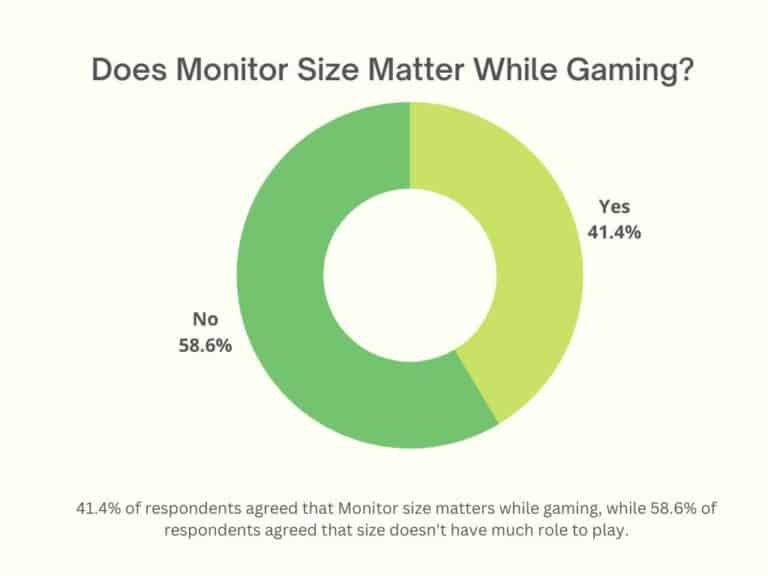
What Is The Best Monitor Size for Gaming?
Any large-sized monitor is appropriate for gaming as it supports a more prominent screen display and higher resolution.
Large monitors are designed to display maximum resolutions such as 2K, 4K, and 8K standard with most modern video games.

On the other hand, small monitors usually only support up to 1080p resolution.
Remember, a monitor smaller than 24 inches is unlikely to offer the benefits of any resolution higher than standard HD: 1080p.
Therefore, 24-inch or anything above will be appropriate for all game types and applicable for Gaming Mouse.
Here are the pros and cons of choosing different gaming monitor sizes;
| Screen Size | Resolution | Pros & Cons |
|---|---|---|
| 14-17″ | 1080p | Pros: Lightweight, easy to move, and takes up less space
Cons: Minimum size and resolution limits high-end gaming experience |
| 23-25” | 1080p | Pros: Versatile Monitor size for all type of work Better for high competitive FPS gamingCons: Limited resolution and refresh rate Low visual quality and speed |
| 27” | 2K or 4K | Pros: Support higher resolution and refresh rate over 60Hz Mostly used by esports gamers Increased screen real estateCons: Slightly costlier and difficult to grasp the entire screen with the same sense of distance |
| 32” | 2K or 4K | Pros: Supports high resolution and high refresh rate games
Cons: Costly, takes up more space, and requires deep desk for optimal viewing |
| 25”-29″ (Ultrawide) | 2560×1080 | Pros: Support high-resolution gaming and appropriate for games made with 21:9 aspect ratio
Cons: Slightly expensive and requires more desk space |
| 34” (Ultrawide) | 3440×1440 | Pros: Best for ultrawide gaming, editing, and content streaming Best for immersive gamingCons: Expensive and not appropriate for games without 21:9 ratio. |
| 43” (Ultrawide) | 3840×1080, 3840×1200 | Pros: Offers home-theater experience for gaming and content streaming
Cons: Expensive and too big for most games and office tasks |
We polled avid gamers to determine which monitor size they prefer while gaming. And here is the answer;
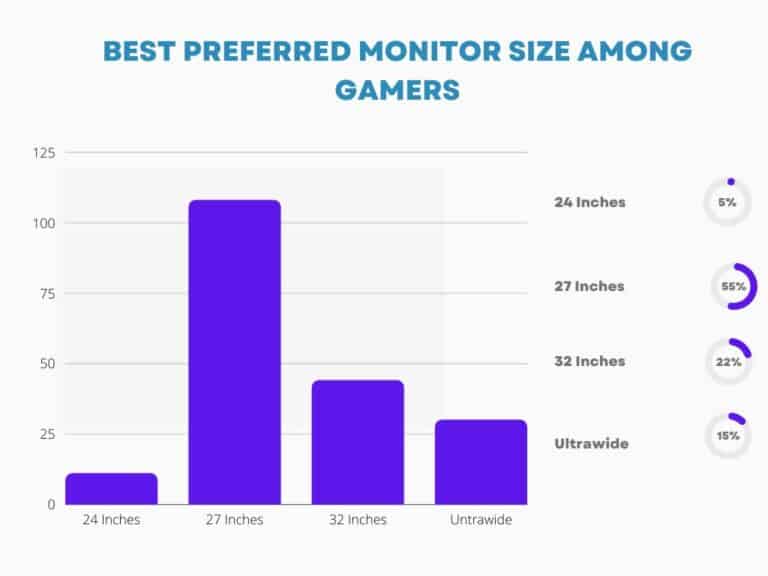
What To Look For In Gaming Monitor?
Although monitor size is the primary consideration when buying a gaming monitor, it is not the only determinant.
Look for features that go along with the appropriate monitor size.
For instance, high-end gaming requires at least 2K or 4K resolution with a 60 to 120Hz refresh rate for speedier response and high dynamic range (HDR).
So, we have laid out the factors in brief that you should seriously consider, along with the screen size.
1. High Refresh and Frame Rate
A higher refresh rate and frame rate guarantee better visual information and precision with lower input lag.
When coupled together, they will offer the best response time, ensuring speedy image transition.
A gamer indulged in fast-paced gaming like Bayonetta, Ghostrunner, and CounterStrike would relate to it.
When looking for a larger monitor size, always go for a higher refresh rate.
| Refresh Rate | What to Expect |
|---|---|
| <60Hz | Too low for high-end gaming and large monitor, causes choppy transition |
| 60Hz | Ensures good motion and compatible with most laptop or computer’s video card |
| 120Hz | Boasts twice as many frame rates and speedier transition but is slightly expensive |
| 144Hz+ | Ensures smooth transition and response time but may require additional video card support |
2. High-End Resolution
Large monitor sizes require higher resolution to compensate for large image sizes.
It is mainly because the more pixels your monitor displays, the sharper and clearer the image you get.
Therefore, when choosing a monitor that is 25 inches or bigger, always look for high-end resolutions such as 2K, 4K, or UHD 4K.
- 25-inch and under 1080p resolution
- 27-inch: 2K or 4K
- 28-inch and over: 4K or UHD 4K
Moreover, your computer or laptop should have a powerful graphics card to support a 4K resolution monitor fully.
3. Anti-Tearing Technology
Tearing is expected when the monitor’s refresh and frame rate vary, causing out-of-sync video output.
Generally, the top and bottom screen frames will be rendered at different frame rates, causing tears across the screen.
Therefore, you should look for a gaming monitor with anti-tearing technologies, such as NVIDIA’s G-Sync, and AMD’s FreeSync.
4. Monitor Inputs
Remember, a gaming monitor only deals with two relevant inputs: HDMI and DisplayPort, which are compatible with FHD, QHD, and UHD resolutions.
Look for monitors that provide HDMI 2.1 port or DisplayPort 1.4 because older versions cannot handle high-resolution displays.
Otherwise, get an adapter for your computer or laptop if the devices lack relevant ports.
Remember, USB-C also supports high resolution and refresh rate but is limited to a few monitor models.
5. Color Consistency
The panel is another consideration for gaming monitors because getting a monitor with a better meeting ensures color consistency.
The three most common panels in gaming monitors are;
- IPS (In-plane switching)
- VA (Vertical alignment)
- OLED panels
IPS panels are more reliable than VA because they offer faster response time and refresh rate.
On the other hand, VA panels offer better color contrast, and OLED panels have darker black shades to help pop out bright elements set against darker backgrounds.
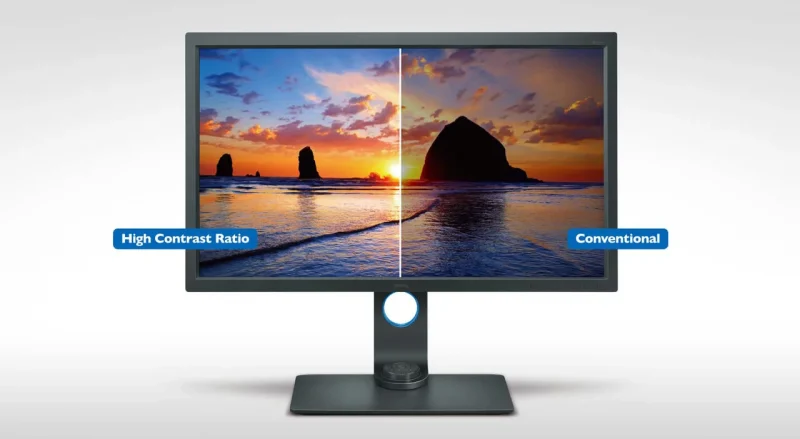
Therefore, the choice entirely relies on your preference.
6. High Dynamic Range
Better HDR ensures an improved viewing experience by providing strong contrast performance and vibrant color output.
Look for a monitor that displays at least 400 cd/m² for optimal viewing, but 600-1,000 cd/m² is better.

24 Inch Vs. 27 Iinch Vs. 32-inch Monitors For Gaming
Talking about gaming monitor sizes, gamers mostly rely on three different sizes, respectively; 24″, 27″, and 32″
Most users may confuse 24″ and 27″ monitors because they resemble each other in dimensions and image quality.
However, comparing a 24″ with a 27″ monitor, you would find vast differences in many aspects.
Here is a table describing the differences between the three monitor sizes;
| 24″ | 27″ | 32″ |
|---|---|---|
| It measures 29.9 cm (vertical) x 53.1 (horizontal) x 60.96 cm (diagonal) | It measures 33.6 cm x 59.8 cm x 68.58 cm | It measures 37.4 cm x 66.4 xm x 78.7 cm |
| It usually supports 1080p or full HD | It supports up to 4K resolution (3840 x 2160) | It supports 4K to 8K resolution (7680 x 4320) |
| Easy-to-read distance: 50-60cm | Easy-to-read distance: 60-70cm | Easy-to-read distance: 80-90cm |
| It offers a compact that perfectly fits on most desks. | It requires some depth during installation to maintain a safe distance, which may take up significant space. | It requires deeper desk space, at least 36″, to accommodate the safe screen distance from your eyes. |
| It is appropraite for small gaming desk setup and usually FPS (First Person Shooting) gaming. | It is appropriate for high-resolution gaming and content streaming. | It is appropriate for high-resolution gaming, editing, publishing, and watching movies. |
| The refresh rate is limited to 60 Hz in most monitors | It supports from 60 Hz to 160 Hz refresh rate for speedier image. | It supports up to 240 Hz refresh rate. |
| You can get one for $139 to $236 | It usually ocsts anywhere between $169 to $269.99 | It usually costs between $165 to $389 |
A 24″ monitor is appropriate for professional and casual gamers, but a 27″ monitor may offer better resolution, high color contrast, and a refresh rate that 24″ will severely lack.
The 32″ monitor might be too big and drain your vision if you fail to keep a safe distance from the monitor.
For optimal experience, consider between 24″ and 27″ monitors. Here are a few recommendations.
| Monitor | Specification | Image |
|---|---|---|
| ASUS ProArt PA248QV | A 24” LED monitor with an effective blue-light filter with anti-glare, Tilt Pivot Swivel, and Height Adjustable with a 16:10 aspect ratio for different tasks. |
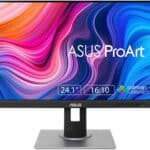 |
| ACER XFA240 | A 24” gaming G-sync monitor with 1080p resolution with height, pivot, and tilt adjustment with anti-glare technology. |
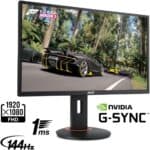 |
| Samsung SH650 | A 27” FHD monitor with 1080p resolution and 16:9 aspect ratio, VESA compatible with USB hub and tilt, swivel, and pivot adjustable. |
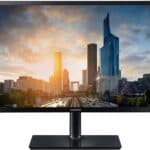 |
| LG 27UD58P-B | A 27” 4K monitor with UHD resolution (2160p) and IPS panel, excellent for both working and gaming. |
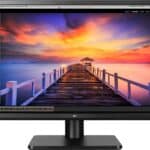 |
| Philips Brilliance 279P1 | 27″ inch display with IPS screen technology, Power-Saving Power Sensor, and height adjustability. |
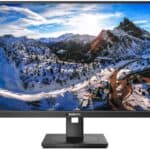 |
Is Ultra-Wide Monitor Good for Gaming?
Ultra-wide monitors come with varying aspect ratios, but all boast wider screen real estate compared to a standard monitor.
An ultra-wide monitor boasts an aspect of 21:9 compared to a standard monitor with 16:9 aspect ratios, meaning you get a wide field of view for a better viewing experience.

Games such as Red Dead Redemption 2, Death Stranding, Microsoft Flight Simulator, and The Witcher III will primarily benefit from broader screen space.
However, not all games support 21:9 or broader ratios. Watching videos and working on office projects such as programming may become a nuisance.
Therefore, choose an ultra-wide monitor at your discretion.

Leave a Reply